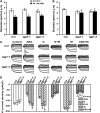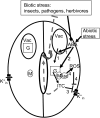Functional proteomics of Arabidopsis thaliana guard cells uncovers new stomatal signaling pathways
- PMID: 19114538
- PMCID: PMC2630442
- DOI: 10.1105/tpc.108.063263
Functional proteomics of Arabidopsis thaliana guard cells uncovers new stomatal signaling pathways
Abstract
We isolated a total of 3 x 10(8) guard cell protoplasts from 22,000 Arabidopsis thaliana plants and identified 1734 unique proteins using three complementary proteomic methods: protein spot identification from broad and narrow pH range two-dimensional (2D) gels, and 2D liquid chromatography-matrix assisted laser desorption/ionization multidimensional protein identification technology. This extensive single-cell-type proteome includes 336 proteins not previously represented in transcriptome analyses of guard cells and 52 proteins classified as signaling proteins by Gene Ontology analysis, of which only two have been previously assessed in the context of guard cell function. THIOGLUCOSIDE GLUCOHYDROLASE1 (TGG1), a myrosinase that catalyzes the production of toxic isothiocyanates from glucosinolates, showed striking abundance in the guard cell proteome. tgg1 mutants were hyposensitive to abscisic acid (ABA) inhibition of guard cell inward K(+) channels and stomatal opening, revealing that the glucosinolate-myrosinase system, previously identified as a defense against biotic invaders, is required for key ABA responses of guard cells. Our results also suggest a mechanism whereby exposure to abiotic stresses may enhance plant defense against subsequent biotic stressors and exemplify how enhanced knowledge of the signaling networks of a specific cell type can be gained by proteomics approaches.
Figures




Comment in
-
Guard cell proteome reveals signals and surprises.Plant Cell. 2008 Dec;20(12):3185. doi: 10.1105/tpc.108.201214. Epub 2008 Dec 29. Plant Cell. 2008. PMID: 19114536 Free PMC article. No abstract available.
References
-
- Acharya, B.R., and Assmann, S.M. (November 25, 2008). Hormone interactions in stomatal function. Plant Mol. Biol. 25 http://dx.doi.org/10.1007/s11103-008-9427-0. - DOI - PubMed
-
- Alexa, A., Rahnenfuhrer, J., and Lengauer, T. (2006). Improved scoring of functional groups from gene expression data by decorrelating GO graph structure. Bioinformatics 22 1600–1607. - PubMed
-
- Amme, S., Rutten, T., Melzer, M., Sonsmann, G., Vissers, J.P., Schlesier, B., and Mock, H.P. (2005). A proteome approach defines protective functions of tobacco leaf trichomes. Proteomics 5 2508–2518. - PubMed
Publication types
MeSH terms
Substances
LinkOut - more resources
Full Text Sources
Other Literature Sources
Molecular Biology Databases

